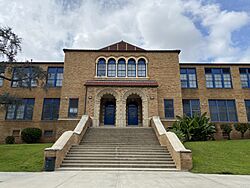University High School (Los Angeles) facts for kids
Quick facts for kids University High School Charter |
|
|---|---|
 |
|
| Address | |
|
11800 Texas Avenue
, 90025
United States
|
|
| Coordinates | 34°02′44″N 118°27′40″W / 34.0456°N 118.461°W |
| Information | |
| Type | Public high school |
| Established | 1924 |
| School district | Los Angeles Unified School District (1961-) Los Angeles City High School District (1924-1961) |
| Principal | Claudia Middleton |
| Teaching staff | 66.61 (FTE) |
| Grades | 9–12 |
| Enrollment | 1,422 (2023–2024) |
| Student to teacher ratio | 21.35 |
| Campus type | Urban |
| Color(s) | Blue and persimmon |
| Athletics conference | CIF Los Angeles City Section Western League |
| Nickname | Wildcats |
University High School Charter, often called "Uni," is a public high school in West Los Angeles, California. It was built between 1923 and 1924 and is part of the Los Angeles Unified School District (LAUSD).
The school is special because its campus includes the Tongva Sacred Springs. These springs are a sacred place for the native Tongva-Gabrieleño people and are a registered California Historical Landmark.
Contents
History of the School
What's in a Name?
When the school was being built, it was called Sawtelle High School. When it opened in 1924, it was named Warren G. Harding High School after the 29th U.S. President, who had recently passed away.
In 1929, the school's name was changed to University High School. This happened after the nearby University of California at Los Angeles (UCLA) moved to Westwood. The name "University" was chosen because student teachers from UCLA would come to the school to practice teaching.
Campus Buildings and Earthquakes
The main administration building was designed to look like old buildings from Italy and Spain. It used to have a tall tower, but it fell during the 1933 Long Beach earthquake.
The school has survived three major earthquakes. The original main building from 1924 is still used today. However, the gym and auditorium were damaged in the 1971 Sylmar earthquake and had to be rebuilt. The football stadium is named after Jackie Robinson, the first African American to play in Major League Baseball.
During World War II, many Japanese-American students were forced to leave the area with their families. Because of this, about one-third of the students in the class of 1942 could not graduate from Uni.
In 2009, the school started a special program called the Academy of Engineering to give students more opportunities in science and technology.
A Special Place: The Tongva Sacred Springs
On the school's campus are the Tongva Sacred Springs, a very important historical site. The native Gabrieleno Tongva people called the springs "Kuruvungna." They have been using the fresh water from these springs since 400 BC. The springs still produce thousands of gallons of water every day.
The springs are in two places on campus. One area is protected by the Gabrielino/Tongva Springs Foundation. Before it was fenced off, students liked to hang out there. The other spring is on the edge of a sports field.
In 1769, a group of Spanish explorers led by Gaspar de Portolà camped at the springs. This expedition helped lead to the founding of Los Angeles. Father Junípero Serra, a famous missionary, is said to have held a church service there.
In 1992, the Gabrielino/Tongva Springs Foundation was created to protect the springs from being damaged by new construction. The foundation now holds a special event every year called "Life Before Columbus Day" to celebrate the history of the Tongva people and their land.
Student Life at Uni
Student Newspapers
The official student newspaper is called the Wildcat. It has been printed since the school first opened. In the past, there were also other student-run newspapers that shared different opinions on topics like the Vietnam War and social issues. One of these papers, the Red Tide, successfully campaigned to change the school's mascot from a "Warrior" to the "Wildcat" in 1997 because the old mascot was seen as disrespectful to Native Americans.
School Information
- Uni offers classes in three languages: French, Spanish, and Mandarin.
- The school serves neighborhoods like Westwood, Bel-Air, and parts of Brentwood. It also welcomes students from other areas like Koreatown and South Los Angeles.
- In 2018, the school became a charter school and changed its name to University High School Charter. This gives the school more freedom in how it teaches and operates.
Uni in the Movies
Because of its classic brick buildings and old-fashioned look, University High is a popular place for filming movies and TV shows. The school's appearance makes it look like an East Coast school, which is rare in Los Angeles.
Filming can sometimes cause disruptions for students, as classrooms and hallways may be temporarily closed. However, the money the school earns from filming helps pay for school programs and improvements.
Productions often make changes to the school for a movie. For the 2008 film Drillbit Taylor, the school was painted and new tiles were installed. The sign on the building was even changed to read "McKinley High School."
Movies and TV Shows Filmed at Uni
Here is a short list of some productions filmed at University High:
- Bruce Almighty (2003)
- Raise Your Voice (2004)
- Freedom Writers (2007)
- Drillbit Taylor (2008)
- Superhero Movie (2008)
- Starstruck (2010)
- Straight Outta Compton (2015)
- My So-Called Life (1994–1995)
- 7th Heaven (1996–2007)
- Lizzie McGuire (2001–2004)
- Modern Family (2011)
Notable Alumni
- List of University High School (Los Angeles) alumni
See also
 In Spanish: Escuela Preparatoria University (Los Ángeles) para niños
In Spanish: Escuela Preparatoria University (Los Ángeles) para niños


